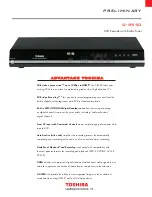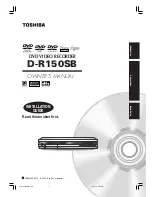
LFH 0388/LFH 0488/LFH 0588
16
Audio signal arrives at the loud speaker, same as in PLAYBACK mode, but its level is redu-
ced (monkey chatter) by R 32 and TS 1:1 (+C from SK 1b to base of TS 1 via R 29).
Via SK 1b +C-voltage arrives at the base of TS 16 via D 15 and R 39; TS 16:1. +C-voltage
arrives at the base of TS 21 via R 86; TS 21:1, TS 20:1 (R 83/R 87 are shorted out); the motor
is now supplied with 3 Volts. The switching over from to is carried out mechanically
by the function ring and by the moving of the bearing assy.
In mode / and with the record button depressed the machine is set in RECORD. But
the BIAS oscillator, the LED control and the Schmitt trigger IC 1 are switched off by SK 1b
(no +B-supply voltage available). The warning tone generator can’t become active.
The microphone signal is muted by TS 1:1 (+C via R 29). During FAST ERASE ( + X /
+ X) the erase head is mechanically turned against the tape by pushing the record button.
If no cassette is loaded or the record protection on the Mini Cassette is initiated, the record
button is blocked via a dedicated scanning lever (erase protection).
Via SK 1b +C-voltage arrives at the base of TS 16 via D 15 and R 39; TS 16:1. +C-voltage
arrives at the base of TS 21 via R 86; TS 21:1, TS 20:1 (R 83/R 87 are shorted out); the motor
is now supplied with 3 Volts. The switching over from to is carried out mechanically
by the function ring and by the moving of the bearing assy.
The motor control operates only in during RECORD and PLAYBACK.
To achieve a constant motor speed (independent on load), the motor voltage is watched by
TS 13. A constant reference voltage is given by D 13, R 62, R 40, R 81, R 82 and TS 19.
The correct motor current is given by TS 16, which is controlled by TS 14; TS 14 is control-
led by TS 13. To avoid switching clicks a special delay time in switching on the motor is given
by C 14, R 57 and D 12. C 38 forms stabilisation for short load changes.
The adjustment of the correct speed of the right hand turntable (38 rpm) can be done by R 40.
In mode STOP the battery voltage can be checked by pressing button SK 10. R 212 repre-
sents a battery load instead of the electronic circuitry. Depending on the battery voltage the
LEDs D 202, D 203 and D 204 are lighting up.
On model LFH 0588 all control functions for the display as well as the timing of all marking
tones (1500 Hz marking tone also produced by the µP) are carried out by a microprocessor,
type COP 920C.
D 201 provides the display with constant supply voltage (switch TS 201:1, R 221 is termina-
ting the current through D 201).
RESET-input (pin 24): When inserting batteries a positive impulse arrives at TS 200 via
C 202; IC 201-24: . C 202 is discharged by D 200.
CLOCK-input (pin 5): The internal clock frequency (approx. 1.2 MHz) of the µP is determi-
ned by R 206 and C 201.
MARKING-input (pin 3): Via SK 4 (logical »0«) the marking sequence is started.
Fast forward
Fast rewind
Fast erase
+
X /
+
X
Motor control
Battery check
(LFH 0588 only)
Microprocessor
(LFH 0588 only)
Summary of Contents for LFH 0388
Page 31: ...LFH 0388 LFH 0488 LFH 0588 29 LFH 0388 LFH 0488 LFH 0588 30 LFH 0388 00 ...
Page 32: ...LFH 0388 LFH 0488 LFH 0588 31 LFH 0388 00 ...
Page 33: ...LFH 0388 LFH 0488 LFH 0588 32 LFH 0488 00 LFH 0588 00 ...
Page 34: ...LFH 0388 LFH 0488 LFH 0588 34 LFH 0388 LFH 0488 LFH 0588 33 LFH 0488 00 LFH 0588 00 ...
















































